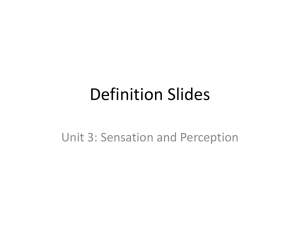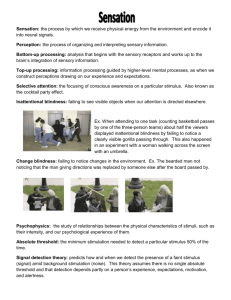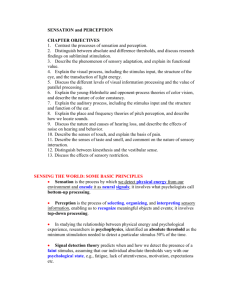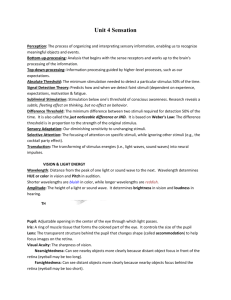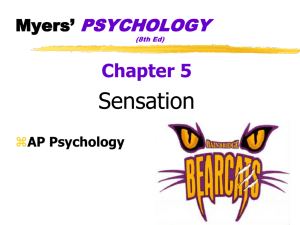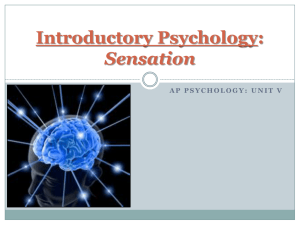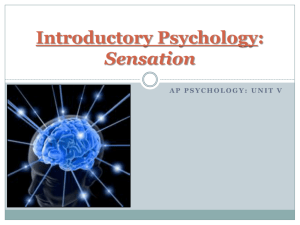Sensation
advertisement
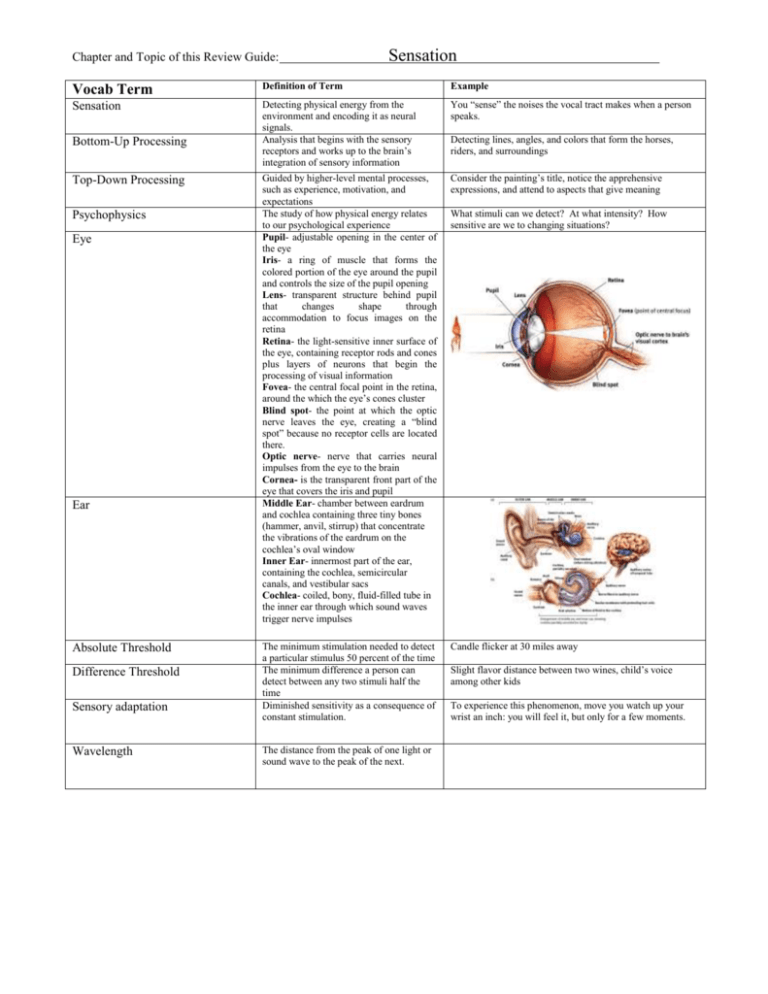
Chapter and Topic of this Review Guide: Sensation Vocab Term Definition of Term Example Sensation Detecting physical energy from the environment and encoding it as neural signals. Analysis that begins with the sensory receptors and works up to the brain’s integration of sensory information You “sense” the noises the vocal tract makes when a person speaks. Guided by higher-level mental processes, such as experience, motivation, and expectations The study of how physical energy relates to our psychological experience Pupil- adjustable opening in the center of the eye Iris- a ring of muscle that forms the colored portion of the eye around the pupil and controls the size of the pupil opening Lens- transparent structure behind pupil that changes shape through accommodation to focus images on the retina Retina- the light-sensitive inner surface of the eye, containing receptor rods and cones plus layers of neurons that begin the processing of visual information Fovea- the central focal point in the retina, around the which the eye’s cones cluster Blind spot- the point at which the optic nerve leaves the eye, creating a “blind spot” because no receptor cells are located there. Optic nerve- nerve that carries neural impulses from the eye to the brain Cornea- is the transparent front part of the eye that covers the iris and pupil Middle Ear- chamber between eardrum and cochlea containing three tiny bones (hammer, anvil, stirrup) that concentrate the vibrations of the eardrum on the cochlea’s oval window Inner Ear- innermost part of the ear, containing the cochlea, semicircular canals, and vestibular sacs Cochlea- coiled, bony, fluid-filled tube in the inner ear through which sound waves trigger nerve impulses Consider the painting’s title, notice the apprehensive expressions, and attend to aspects that give meaning The minimum stimulation needed to detect a particular stimulus 50 percent of the time The minimum difference a person can detect between any two stimuli half the time Diminished sensitivity as a consequence of constant stimulation. Candle flicker at 30 miles away Bottom-Up Processing Top-Down Processing Psychophysics Eye Ear Absolute Threshold Difference Threshold Sensory adaptation Wavelength The distance from the peak of one light or sound wave to the peak of the next. Detecting lines, angles, and colors that form the horses, riders, and surroundings What stimuli can we detect? At what intensity? How sensitive are we to changing situations? Slight flavor distance between two wines, child’s voice among other kids To experience this phenomenon, move you watch up your wrist an inch: you will feel it, but only for a few moments. Hue The dimension of color that is determined by the wavelength of light; what we know as the color names blue, green and so forth. Intensity The amount of energy in a light or sound wave, which we perceive as brightness or loudness, as determined by wave’s amplitude. The process by which the eye’s lens changes shape to focus near or far objects on the retina. Retinal receptors that detect black, white and gray; necessary for the peripheral and twilight vision, when cones don’t respond. Retinal receptor cells that are concentrated near the center of the retinal and that function in daylight or in well-lit conditions. The cones detect fine detail and give rise to color sensations. The theory that opposing retinal processes enable color vision. Accommodation Rods Cones Opponent-process theory Frequency Pitch Frequency theory (alternative to place theory) Conduction hearing loss Sensorineural hearing loss Kinesthesis Vestibular sense Sensory interaction The number of complete wavelengths that pass a point in a given time. A tone’s experienced highness or lowness; depends on frequency. In hearing, the theory that the rate of nerve impulses traveling up the auditory nerve matches the frequency of the tone, thus enabling us to sense its pitch. Hearing loss caused by damage to the mechanical system that conducts sound waves to the cochlea. Hearing loss caused by damage to the cochlea’s receptor cells or to the auditory nerves also called nerve deafness The system for sensing the position and movement of individual body parts. The sense of body movement and position including the sense of balance. The principle that one sense may influence another, as when the smell of food influences its taste. Example a) above Example b) above. For example some cells are stimulated by green and inhibited by red; others are stimulated by red and inhibited by green. Authors of Important Study Basic of What Was Done Lesson(s) learned from the study David Hubel and Torsten Wiesel Demonstrated that neurons in the occipital lobe’s visual cortex receive information from individual ganglion cells in the retina. Parallel processing- the processing of many aspects of a problem simultaneously; the brain’s natural mode of information processing for many functions including vision. Contrasts with the step-by-step processing of most computers and f conscious problem solving. Feature detector- nerve cells in the brain that respond to a specific features of the stimulus, such as shape, angle or movement. Studies of patients with brain damage suggest that the brain delegates the work of processing color, motion, form, and depth to different areas. After taking a scene apart, how does the brain integrate these sub dimensions into the perceive image? The answer is the Holy Grail of vision research. Young-Helmholtz theory- the theory that the retina contains three different color receptors- one most sensitive to red, one to green, one to blue- which when stimulated in combination, can produce the perception of any color. Theory that the spinal cord contains a neurological “gate” that blocks pain signals or allows them to pass on to the brain. The “gate” is opened by the activity of pain signals traveling up small nerve fibers and is closed by activity in larger fibers or by information coming from the brain. Livingston & Hubel Young and Helmholtz Inferred that the eye must have three corresponding types of color receptors. Ronald Melzach and Patrick Wall Gate control theory Name of Important Person What this person is known for Impact on Psychology Ernst Webber Webber’s Law: the principle that, to be perceived as different, two stimuli must differ by a constant minimum percentage (rather than a constant amount). Presumes that we hear different pitches because different places along cochlea’s basilar membrane. This law gave us something so simple but at the same time something so widely applicable. Hermann von Helmholtz Place theory- in hearing, the theory that links the pitch we hear with the place where the cochlea’s membrane is stimulated.
